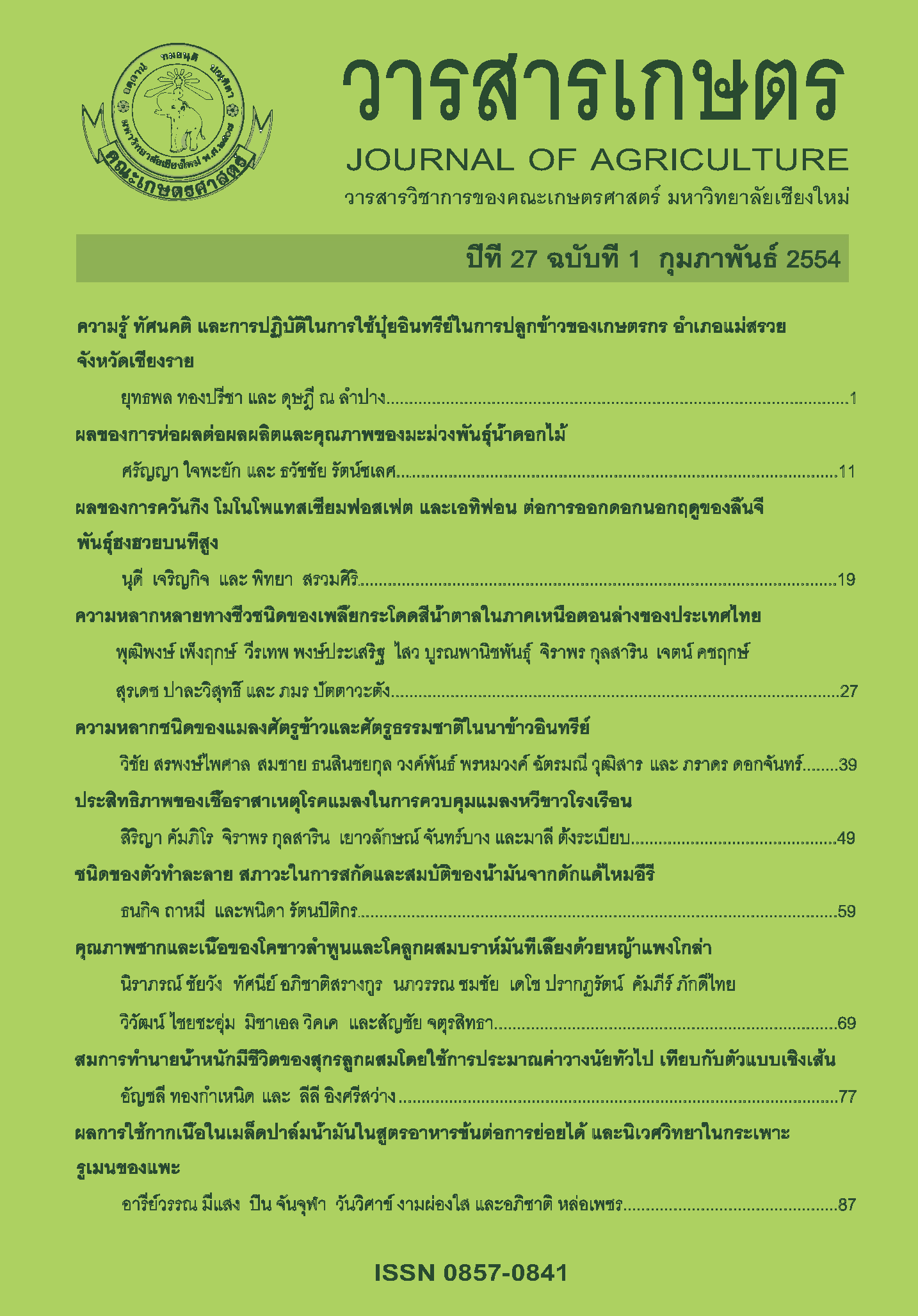ประสิทธิภาพของเชื้อราสาเหตุโรคแมลงในการควบคุมแมลงหวี่ขาวโรงเรือน
Main Article Content
บทคัดย่อ
วัตถุประสงค์ของการวิจัยนี้คือ ศึกษาประสิทธิภาพของเชื้อราสาเหตุโรคแมลงในการควบคุมแมลงหวี่ขาวโรงเรือน Trialeurodes vaporariorum Westwood ในห้องปฏิบัติการ โดยทดสอบการเข้าก่อโรคของเชื้อราสาเหตุโรคแมลง จำนวน 29 ไอโซเลท จากเชื้อ 17 ชนิด ใน 5 สกุล ด้วยการพ่นสารแขวนลอยสปอร์ของเชื้อรา ที่ระดับความเข้มข้น 1x 108 สปอร์/มิลลิลิตร ลงบนตัวอ่อนแมลงหวี่ขาวโรงเรือนวัยที่ 2 พบว่า มีเชื้อราเพียง 6 ไอโซเลท จากเชื้อ 6 ชนิด ใน 3 สกุล ที่สามารถทำให้แมลงหวี่ขาวโรงเรือนเกิดโรคตายได้ โดยมีอัตราการตายระหว่างร้อยละ 3.85 - 92.44 เชื้อรา Paecilomyces tenuipes ไอโซเลท Pt 6073 ก่อโรคกับแมลงหวี่ขาวโรงเรือนสูงสุดร้อยละ 92.44 รองลงมาคือเชื้อรา Metarhizium anisopliae ไอโซเลท BCC 4849 มีค่าร้อยละ 72.67 โดยมีค่า LC50 2.219 x 106 และ 1.005 x 107 สปอร์/มิลลิลิตร ตามลำดับ ที่เวลา 7 วัน หลังจากได้รับเชื้อ
Article Details
เอกสารอ้างอิง
อัมพร วิโนทัย. 2552. การใช้แมลงศัตรูธรรมชาติควบคุมแมลงศัตรูผัก. (ระบบออนไลน์). แหล่งข้อมูล: www.kmitl.ac.th/hydro/Hydr-Pest/AmponW.pdf (18 สิงหาคม 2552).
Evans, H. C. and N.L. Hywel-Jones. 1990. Aspects of the genera Hypocrella and Aschersonia as pathogens of coccids and whiteflies. pp. 111–115. In: D.J. Cooper, J. Drummond and D.E. Pinnock (eds.). Proceedings of the 5th International Colloquium on Invertebrate Pathology and Microbial Control, Society for Invertebrate Pathology, Adelaide, Australia.
Finney, D. J. 1971. Probit Analysis. 3rd ed. Cambridge University Press, Cambridge. 333 pp.
Fransen, J.J. 1990. Natural enemies of whiteflies: fungi. pp. 187–210 In D. Gerling (ed.). Whiteflies: Their Bionomics, Pest Status and Management. Intercept, Andover, UK.
Gökçe, A. and M. Kubilay. 2005. Pathogenicity of Paecilomyces spp. to the glasshouse whitefly, Trialeurodes vaporariorum, with some observations on the fungal infection process. Turk. J. Agric. For. 29: 331-339.
Humber, R.A. 1992. Collection of Entomopathogenic Fungal Cultures: Catalog of Strains. Publ. No. ARS-110, USDA. ARS, Beltsville, MD. 177 pp.
Intamas, S., S. Supothina, K. Tasanatai and M. Isaka. 2009. Quantitative analysis of beauvericin in natural specimen and cultivated synnemata of the lepidopteran pathogen Isaria tenuipes. In: Book of Abstracts. International Conference on Fungal Evolution and Charles Darwin: From Morphology to Molecules. (Online). Available: http://www.slideshare.net/nstda/ abtracts-charles-darwin (September 10, 2009).
Lacey, L.A., J.J. Fransen and R. Carruthers. 1996. Global distribution of naturally occurring fungi of Bemisia, their biologies and use as biological control agents. pp. 401-433 In: D. Gerling and R.T. Mayer (eds.). Bemisia 1995: Taxonomy, Biology, Damage, Control and Management. Intercept, Andover, UK.
Quinlan, R.J. 1988. Use of fungi to control insects in glasshouses. pp. 19-36. In: M.N. Burge, (ed). Fungi in Biological Control Systems. Manchester University Press, Manchester, UK.
Shimizu, S., S. Isayama and E. Nitta. 2006. Insecticidal Paecilomyces tenuipes strain FERM BP-7861. (Online). Available: http://www.freepatentsonline.com/7033586.pdf (September 10, 2009).
Smith, P. 1993. Control of Bemisia tabaci and the potential of Paecilomyces fumosoroseus as a biopesticide. Biocontrol News and Information 14: 71N-78N.
Sterk, G., K. Bolckmans and J. Eyal. 1996. A new microbial insecticide, Paecilomyces fumosoroseus strain Apopka 97, for the control of the greenhouse whitefly. pp. 461-466. In: Proceedings of Brighton Crop Protection Conference: Pests and Disease. 18-21 November 1996, Brighton, UK.
Zhu, J.S., G.M. Halpern and K. Jones. 1998. The scientific rediscovery of a precious ancient Chinese herbal regimen: Cordyceps sinensis. Part II. J. Altern Complement Med. 4: 429-457.


